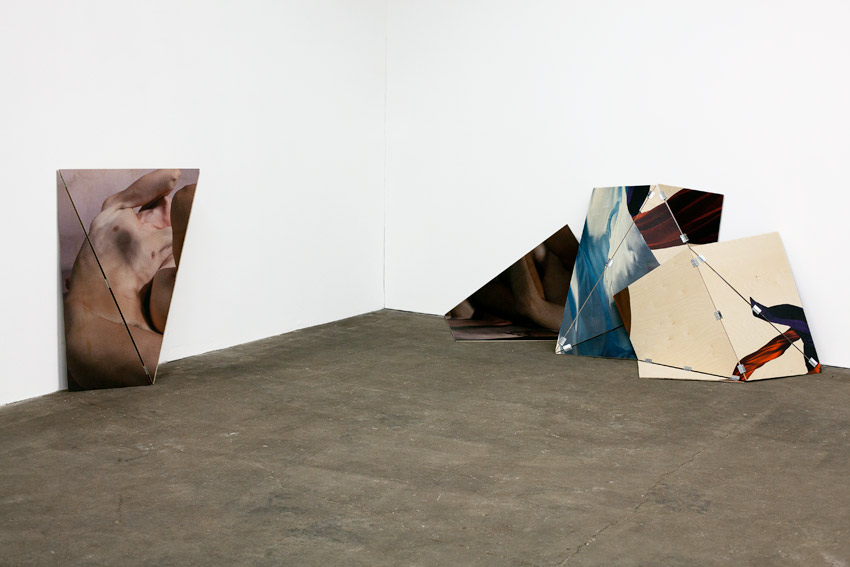Matthew Stone: Seeing the Unseen

Matthew Stone makes art school anachronistic. Although he graduated from Camberwell Art School in 2004 with a first in painting, the London-based artist has established a re-engaging art through happenings, popular salons, and other invigorating extracurricular creativity. Stone works with a dash Bloomsbury Group and a pinch Aleister Crowley; to hear Sir Norman Rosenthal say it, “he has invented a new ‘ism’—Optimism.” Stone’s latest hope for art is expressed in “All That Is Unseen” at the Allan Nederpelt Gallery in Brooklyn. The show includes Stone’s “Interconnected Echoes,” salon, previously at the Tate Modern and ICA with Marina AbramoviÄ? and AA Bronson. We discussed spirituality, art and learning with the artist.
ANA FINEL HONIGMAN: What are you doing in the show?
MATTHEW STONE: I’ve produced a series of folded wooden sculptures with photographs of bodies on the surfaces. The “folds” are hinged so that I can reinstall the works in relation to each other in different ways. So they can be seen as evolving pieces, not static or permanent physical structures. I have worked for a while with the sculptural installation of photography. I like the idea of pushing one-dimensional plane into and through others. As a society, we are focused on material reality, and our bodies are our direct link to that physicality. We sometimes touch other people’s bodies, but more often, we are touched by their minds. It’s these complex intellectual, emotional and metaphysical interactions that interest me. It’s all conversation of one kind or another. I am also hosting a “salon,” which is basically a non-hierachical discussion forum. We will be talking about art and spirituality.
HONIGMAN: Aren’t all artists shamans, in a sense? I think so.
STONE: I think so, too. I understand both terms to describe people who choose to subject themselves to intense psychological experiences and induce extraordinary thinking. The subjective knowledge they gain is then shared with a community through poetic metaphor and storytelling. Within shamanism, there is an emphasis on the transformational healing potential that this transfer of knowledge holds. Contemporary artists seem more reluctant to define their activities within this framework, but I think that it’s a useful conversation to occur.
HONIGMAN: Are metaphysical concerns inherently part of all art?
STONE: The way we process art is metaphysical. The thoughts, intuitions and feelings that arise when encountering an artwork have no concrete physical form, and they can’t be entirely measured. At the point that these internal dialogues and processes are externalized, even verbally, they are given a physical and quantifiable form. These forms have the potential to be recognized as artworks of their own. I think this is what the artist Joseph Beuys meant when he proclaimed everyone an artist.
HONIGMAN: How spiritual are you?
STONE: I think it’s important to make a distinction between the dogmatic ideologies of religion and what I might choose to describe as a secular spirituality. I think that spiritual thinking and metaphysical aspiration is constantly reformatted to meet the needs of particular times, contexts and individuals. It can be misleading as a term to the extent that when people hear it they shut off entirely. But in my mind anybody who knows anything of the landscape of love is a spiritual person.
HONIGMAN: How does this manifest in your life?
STONE: It manifests as a desire to engage, collaborate and learn from other people.
HONIGMAN: What do you think is “behind the veil”?
STONE: I understand the term to mean something similar to “esoteric,” which translates as “that which is hidden.” I think that the original desire and impulse to reach beyond material reality and enter psycho-spiritual worlds, remains in today’s society. People still dance, take drugs, and immerse themselves in movies, sport, and music to alter, heighten, and enchant their experiences of reality. It could be said that this intuitive spiritual behavior now occurs without a sacred dimension or socially conscious context. Whilst it is easy to perceive authenticity in the traditions of the past, I also think it’s useful to optimistically read, find, and create meaning in our current day-to-day activities.
HONIGMAN: How do the educational and knowledge-giving beliefs of Marina AbramoviÄ? and AA Bronson relate to your pedagogical approach?
STONE: Anybody that produces culture is in a position of influence, and becomes a leader of sorts to other people. An artist can do more than make expensive objects. Artists should live to inspire others to further their own unique creative potential within the world. That is also the role of the artist, the shaman, and the teacher.
HONIGMAN: When do you feel that your salon is successful?
STONE: I have been part of discussions where I have actually seen an idea explode. It’s not just that a thought has been debunked or pushed to a logical conclusion. It is a momentary and intuitive feeling that all ideas are living and evolving multidimensional beings borne to connect all human activity and history forever.






